SANAA’s unmistakable signature is evident in this emblematic chair designed by Ryue Nishizawa and Kazuyo Sejima, embodying the design philosophy of the firm.
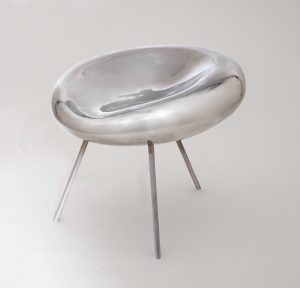
Image source:https://platform-0.com/sanaa-drop-chair-2005/
Shapes of Nature
SANAA’s distinctive design is unmistakable in this emblematic piece furniture: the main source of inspiration for the firm has always been identified inanimalsandnature, following the idea ofbalanceandlightness. One of their major pieces is undoubtedly the “drop chair”, designed for the21st Century Museum of Contemporary Art, inKanazawa.Kazuyo SejimaandRyue Nishizawa, the two heads of SANAA studio, set on designing a raindrop-shaped armless chair, completely made inaluminum. The raindrop is the perfect example of balanced change, as by falling down causes a movement, making a moderate ripple on the surface of the pond. The material reflects the surrounding, imparting a sense oflightnessto the structure, strengthened by its three thin chair legs, made of metal as well.
An analogously important piece, found in the samr museum, is theNextmaruniarmless chair, designed keeping in mind the form ofrabbit earsand realized innatural birch; it is, possibly, a testimony toSANAA‘s notable collaboration withAlessi, the Italian design company known for reinventing the design of everyday objects using colorful, plaything-like designs, with whom they produced a tea service in sleek, stainless steel, with the boilers being all notably shaped like apples and pears, adding SANAA’s own natural touch to a traditionally industrial aesthetic.
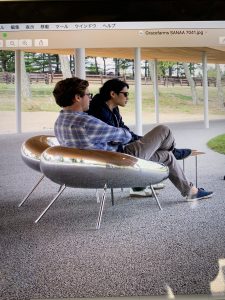
Image source:https://platform-0.com/sanaa-drop-chair-2005/
The story of SANAA
SANAA is a Japanese firm founded byKazuyo SejimaandRyue Nishizawa, in1995; in a few years, the brand has established itself on the international stage as one of the major and most impactful architectural firms of the 21st century. The unmistakable signature of the brand is theirdistinctive minimalism, which made SANAA protagonist of projects like theNew MuseuminNew York, the circular production facility of theVitra Campus, as well as the sereneLouvre-LensinFrance.
As for the architects themselves,Sejimawas born in Tokyo, where she studied Architecture. After receiving her degree, she opened her own studio, and was later rewarded asYoung Architect of the Yearby the Japan Institute of Architects.Ryue Nishizawagraduated with a Master’s degree in Architecture at the Yokohama National University, and during this period he met Sejima. After a collaboration lasting for several years, Nishizawa and Sejima founded SANAA, or “Seijima and Nishizawa and Partners”.
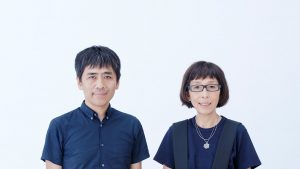
(Photo by Takashi Okamoto).
Image source:https://www.arch.virginia.edu/news/kazuyo-sejima-ryue-nishizawa-2019-thomas-jefferson-medalists-in-architecture. Author:Caroline Newman
All About Inclusiveness
SANAA’s distinctive style is focused on the brand’s ultimate goal: toencourage interaction with the environment and the architecture. This philosophy leads to abstract,minimalistspaces, not rarely of transparent materials or patterns. This minimalism is oriented to the personalization and interpretation of the surroundings, with no preconception, promoting the idea that a building is not completed until it is inhabited. This immaterial physical space seems to show almost no physical details, as a blank canvas: glass, concrete and soft structure, in addition to a magistral use of light, draw ephemeral forms, helping the visitor to focus on the social dimension of a building. SANAA’s philosophy is as far as possible from an aseptic vision of the building as “white box”, but is an attempt to draw the attention on the deepest essence of the architecture: thehuman beings.
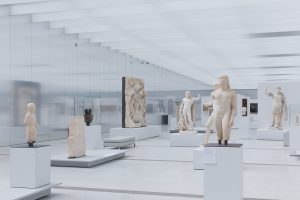
Image source:https://search.creativecommons.org/photos/005a6541-5628-414d-b544-23b51be218e3by準建築人手札網站 Forgemind ArchiMedia
A case point is the21st Century Museum of Contemporary Artin Kanazawa, which embodies the concept of “city within a city”,包含更小的矩形包围ed by a transparent circle. In this way was created a pattern-breaking space, which promotes the free circulation between different zones. SANAA’sRolex Learning Centerin Switzerland underlines the focus on humanity and the sociality of the firm. This minimalist space refuses every form of barrier, featuring an open space lit by large windows, which create a play of lights on the neutral environment. The grouping is encouraged also by shared spaces, circular tables and chairs, to promote sharing knowledge and team working.
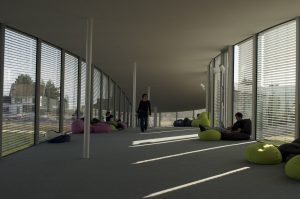
Image source:https://search.creativecommons.org/photos/006f24a6-9426-4ae4-9fac-3da286a3ae50byPaoloMazzoleni
Info sources:
https://designdefender.com/designers/sanaa/
https://divisare.com/authors/10419-sanaa-kazuyo-sejima-ryue-nishizawa
